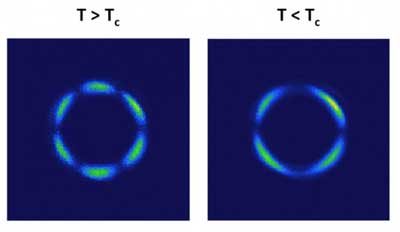| Posted: Dec 14, 2017 |
The first three-dimensional quantum liquid crystal
(Nanowerk News) Scientists discovered an entirely new class of novel electronic structures. They discovered a liquid crystal-like quantum phase of matter in a 3-D material. The onset of this phase at the transition temperature is very subtle, yet, like a rudder steering a large ship, it drives a much larger effect—a structural phase transition (Science, "A parity-breaking electronic nematic phase transition in the spin-orbit coupled metal Cd2Re2O7").
|
 |
| Using optical second harmonic generation spectroscopy, scientists discovered a new state of matter. The patterns show reflected laser light at twice the initial laser frequency observed when illuminating the metal Cd2Re2O7. The patterns were collected from Cd2Re2O7 crystals at temperatures that were above (left) and below (right) a structural phase transition temperature (Tc), which occurs at 200 Kelvin. Scientist have concluded that the low-temperature pattern arises from a 3-D quantum liquid crystal. (Image: David Hsieh, California Institute of Technology)
|
|
This discovery represents a quantum analog of classical 3-D liquid crystals. These new structures are among those that are observed as a consequence of competing interactions in 3-D metals. The competitions lead to phenomena such as ferromagnetism, which leads to the formation of permanent magnets, and superconductivity that allows electrical current to flow with zero resistance. This new class of materials may have applications in ultrafast computers.
|
|
The spatial arrangement of atoms and electrons in a material is often characterized by its symmetry, which has an important role in determining the electronic properties of the material. In materials where conduction electrons are strongly interacting, it is possible for electronic configurations to exhibit a different symmetry than the underlying crystal lattice.
|
|
The material Cd2Re2O7 is a poor metal characterized by strong electron-electron interactions and coupling between the electron’s spin orientation and orbital motion in atoms.
|
|
This material undergoes a structural phase transition at a critical transition temperature (200 Kelvin) where the crystal structure changes from cubic to tetragonal. The question is, what drives this transition and how might it be related to the electronic structure and interactions?
|
|
Researchers obtained patterns of reflected light by illuminating a Cd2Re2O7 crystal with a laser and then collecting the reflected light that has been converted to twice the frequency of the initial laser. Changes in the pattern led scientists to conclude that the temperature-dependent phase transition is driven by an unusual electronic liquid crystalline (nematic) order that spontaneously breaks certain types of symmetry (rotational and inversion) in the crystal.
|
|
Scientists also demonstrated that the structural transformation follows, or is subject to, the electronic transition rather than the more commonly observed process where a structural transformation changes the electronics. Such nematic order was theoretically predicted to appear in correlated metals with strong spin-orbit coupling and may be a precursor to long-sought topological superconductivity.
|

